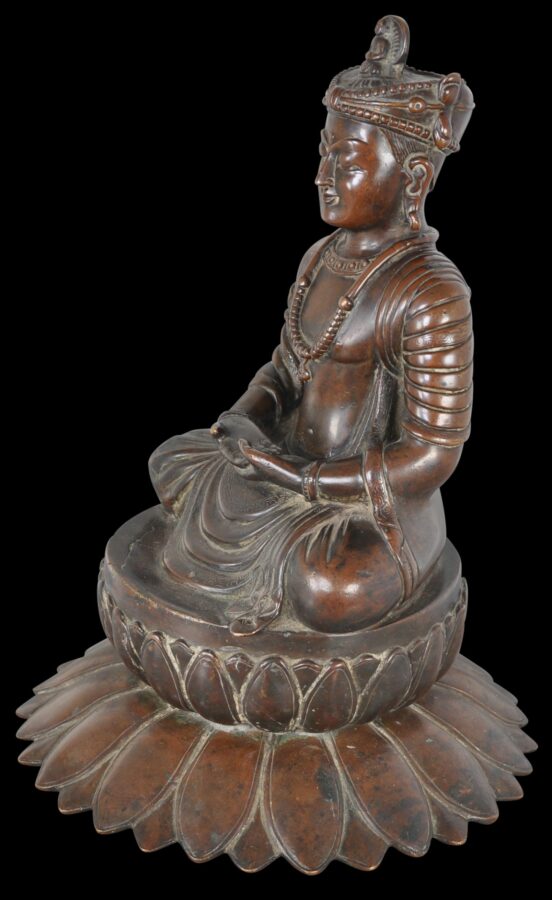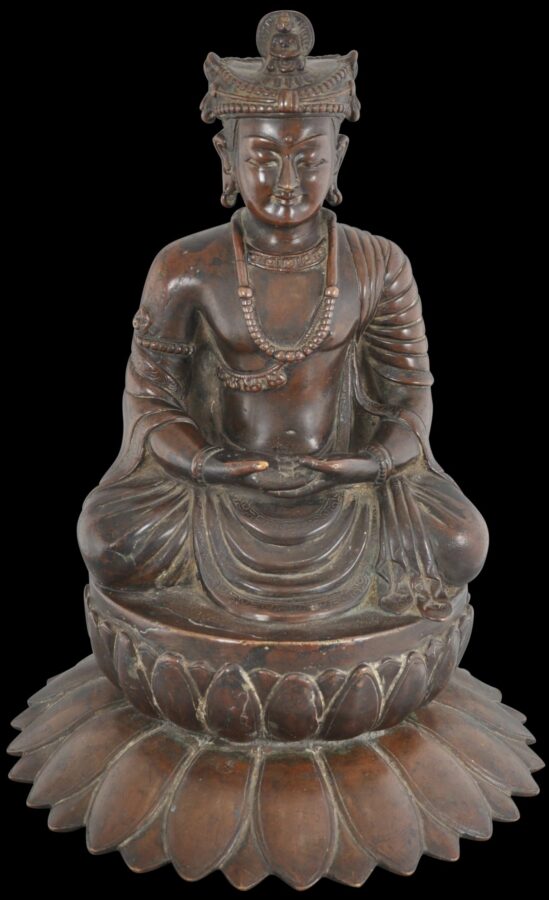This exceptionally well-cast bronze comprises a highly detailed portrait image of what is likely to be a deified member of the Nepalese ruling elite. It is likely to have been a one-off commission.
The image shows a male aristocrat seated cross-legged, and with hands in the meditative dhyani mudra position, on a high, double-lotus throne. Copious robes are draped over the legs and left shoulder in a manner that shows lots of pleating, with the edges finely engraved with scrolling motifs. The figure wears ample necklaces and bracelets, and a Malla-style headdress.
The face is beautifully rendered: it is round, expressive, with pursed lips and the elongated earlobes of a prince. There is a prominent, raised, circular urna on the forehead. A figure of a seated Buddha is in the headdress. The fingers are finely cast – with all the appropriate folds and creases.
On the reverse, on the deity’s upper back, there is a rectangular lug – perhaps it was designed to hold an umbrella over the deity.
The alloy used to cast the image is a copper alloy probably with a high zinc content, this being more typical of later Nepalese casting.
As befitting of a later Nepalese bronze, given Nepal’s openness to outside influence and being at the centre of migratory and commercial cross-roads, the image shows a range of influences that draw on motifs and themes from northern India and across the Himalayas.
Waldschmidt (1967) illustrates a silver image of a Nepalese Maitreya which similarly features a double-lotus pedestal which seems to draw on early Kashmir bronzes, and a headdress, which also appears to draw on Gandharan influence. Indeed, some elements of the jewellery, costume and headdress dome seem to related to stone Gandharan portrayals of Maitreya of the 2nd-3rd century. Colonial British archaeological surveys in the Gandharan and Kashmiri regions of northern India from the mid-19th century unearthed large quantities of Gandharan stone sculptures and Kashmiri bronzes. These were documented, illustrated and many entered colonial museums so it is possible that the casters of the image here were influenced by these new discoveries. The well-cast and realistic, plump face suggests Chinese influence, often seen on Yuan Dynasty depictions of the Buddha for example
The image is in excellent condition. The features show some smoothness from wear and the bronze has a good, varying, brown patina. The underside of the base has good contact wear, where it has come into contact with whatever it has sat on.
Overall, the image is highly decorative and beautifully cast.
References
Pal, P., Himalayas: An Aesthetic Adventure, The Art Institute of Chicago, 2004.
Waldschmidt, E & R.L., Nepal: Art Treasures from the Himalayas, Elek Books, 1967.













